PUBH630 - Obesity: Examining Personal, Social, & Government Roles
VerifiedAdded on 2023/04/12
|9
|2955
|219
Essay
AI Summary
This essay examines the multifaceted issue of obesity, exploring its nature, scale, and critical behavioral risk factors such as unhealthy diets and physical inactivity. It delves into the determinants of obesity, including genetic predispositions, financial stress, physical inactivity, socio-economic status, age, and medical conditions. The essay analyzes the relationship between these determinants and addresses the central question of whether obesity is primarily a personal responsibility or a social/governmental one. It argues that while individual choices play a role, the increasing prevalence of obesity is also influenced by societal factors like the availability of cheap, unhealthy food and marketing practices. The essay concludes that addressing obesity requires a joint effort involving both personal responsibility and government interventions such as regulations on unhealthy foods, advertising restrictions, and improved food labeling, emphasizing the importance of values like self-determination, solidarity, and fairness in promoting responsible behavior and achieving a healthier community.
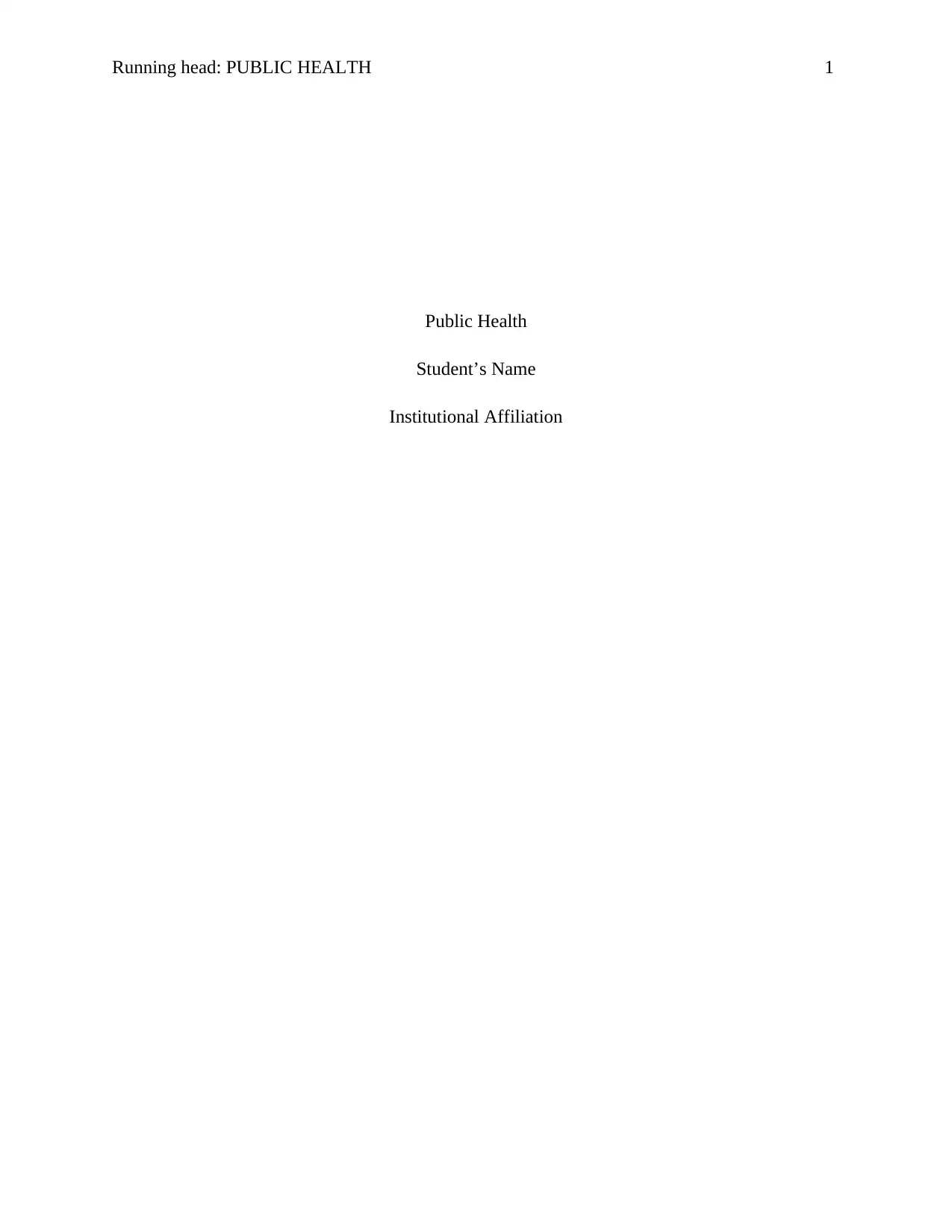
Running head: PUBLIC HEALTH 1
Public Health
Student’s Name
Institutional Affiliation
Public Health
Student’s Name
Institutional Affiliation
Paraphrase This Document
Need a fresh take? Get an instant paraphrase of this document with our AI Paraphraser
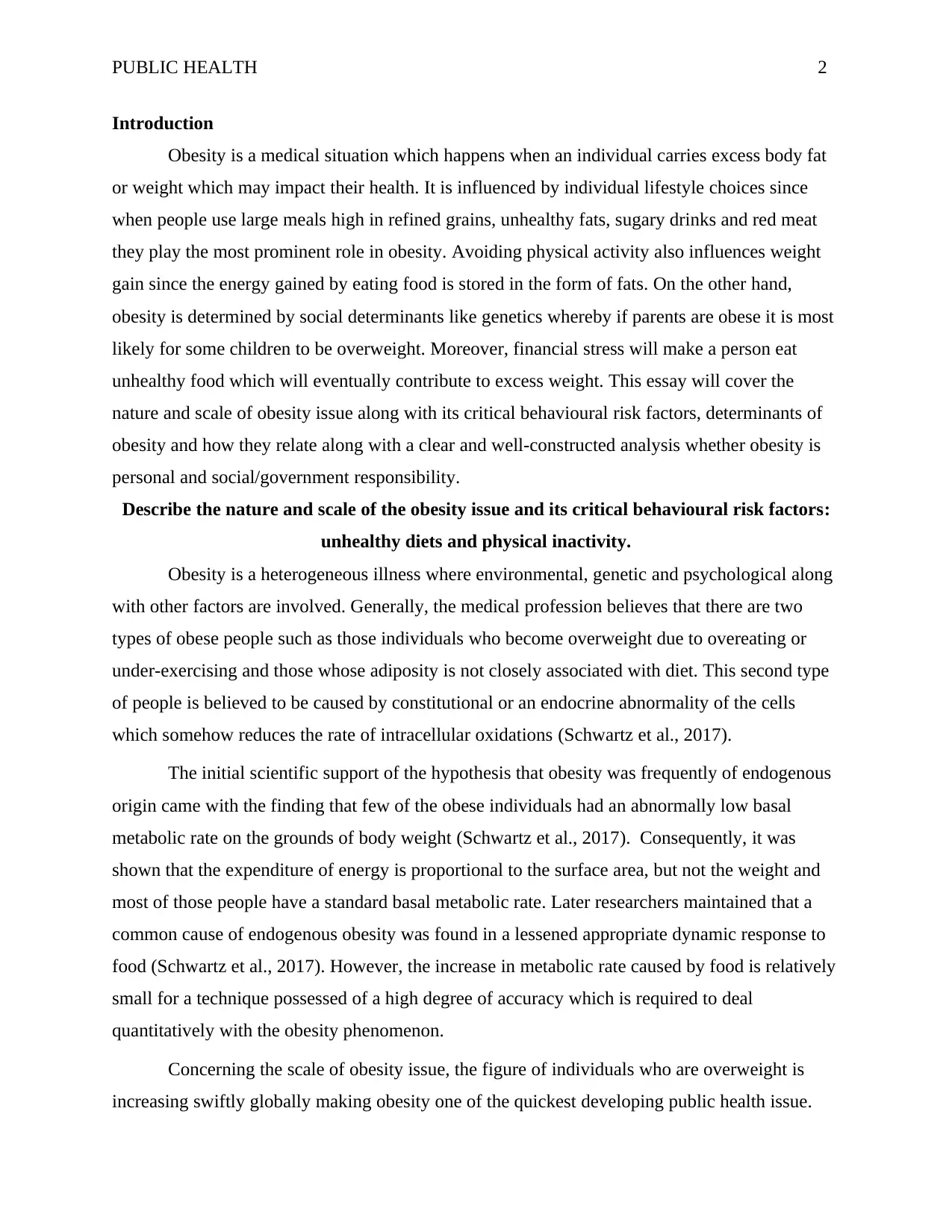
PUBLIC HEALTH 2
Introduction
Obesity is a medical situation which happens when an individual carries excess body fat
or weight which may impact their health. It is influenced by individual lifestyle choices since
when people use large meals high in refined grains, unhealthy fats, sugary drinks and red meat
they play the most prominent role in obesity. Avoiding physical activity also influences weight
gain since the energy gained by eating food is stored in the form of fats. On the other hand,
obesity is determined by social determinants like genetics whereby if parents are obese it is most
likely for some children to be overweight. Moreover, financial stress will make a person eat
unhealthy food which will eventually contribute to excess weight. This essay will cover the
nature and scale of obesity issue along with its critical behavioural risk factors, determinants of
obesity and how they relate along with a clear and well-constructed analysis whether obesity is
personal and social/government responsibility.
Describe the nature and scale of the obesity issue and its critical behavioural risk factors:
unhealthy diets and physical inactivity.
Obesity is a heterogeneous illness where environmental, genetic and psychological along
with other factors are involved. Generally, the medical profession believes that there are two
types of obese people such as those individuals who become overweight due to overeating or
under-exercising and those whose adiposity is not closely associated with diet. This second type
of people is believed to be caused by constitutional or an endocrine abnormality of the cells
which somehow reduces the rate of intracellular oxidations (Schwartz et al., 2017).
The initial scientific support of the hypothesis that obesity was frequently of endogenous
origin came with the finding that few of the obese individuals had an abnormally low basal
metabolic rate on the grounds of body weight (Schwartz et al., 2017). Consequently, it was
shown that the expenditure of energy is proportional to the surface area, but not the weight and
most of those people have a standard basal metabolic rate. Later researchers maintained that a
common cause of endogenous obesity was found in a lessened appropriate dynamic response to
food (Schwartz et al., 2017). However, the increase in metabolic rate caused by food is relatively
small for a technique possessed of a high degree of accuracy which is required to deal
quantitatively with the obesity phenomenon.
Concerning the scale of obesity issue, the figure of individuals who are overweight is
increasing swiftly globally making obesity one of the quickest developing public health issue.
Introduction
Obesity is a medical situation which happens when an individual carries excess body fat
or weight which may impact their health. It is influenced by individual lifestyle choices since
when people use large meals high in refined grains, unhealthy fats, sugary drinks and red meat
they play the most prominent role in obesity. Avoiding physical activity also influences weight
gain since the energy gained by eating food is stored in the form of fats. On the other hand,
obesity is determined by social determinants like genetics whereby if parents are obese it is most
likely for some children to be overweight. Moreover, financial stress will make a person eat
unhealthy food which will eventually contribute to excess weight. This essay will cover the
nature and scale of obesity issue along with its critical behavioural risk factors, determinants of
obesity and how they relate along with a clear and well-constructed analysis whether obesity is
personal and social/government responsibility.
Describe the nature and scale of the obesity issue and its critical behavioural risk factors:
unhealthy diets and physical inactivity.
Obesity is a heterogeneous illness where environmental, genetic and psychological along
with other factors are involved. Generally, the medical profession believes that there are two
types of obese people such as those individuals who become overweight due to overeating or
under-exercising and those whose adiposity is not closely associated with diet. This second type
of people is believed to be caused by constitutional or an endocrine abnormality of the cells
which somehow reduces the rate of intracellular oxidations (Schwartz et al., 2017).
The initial scientific support of the hypothesis that obesity was frequently of endogenous
origin came with the finding that few of the obese individuals had an abnormally low basal
metabolic rate on the grounds of body weight (Schwartz et al., 2017). Consequently, it was
shown that the expenditure of energy is proportional to the surface area, but not the weight and
most of those people have a standard basal metabolic rate. Later researchers maintained that a
common cause of endogenous obesity was found in a lessened appropriate dynamic response to
food (Schwartz et al., 2017). However, the increase in metabolic rate caused by food is relatively
small for a technique possessed of a high degree of accuracy which is required to deal
quantitatively with the obesity phenomenon.
Concerning the scale of obesity issue, the figure of individuals who are overweight is
increasing swiftly globally making obesity one of the quickest developing public health issue.
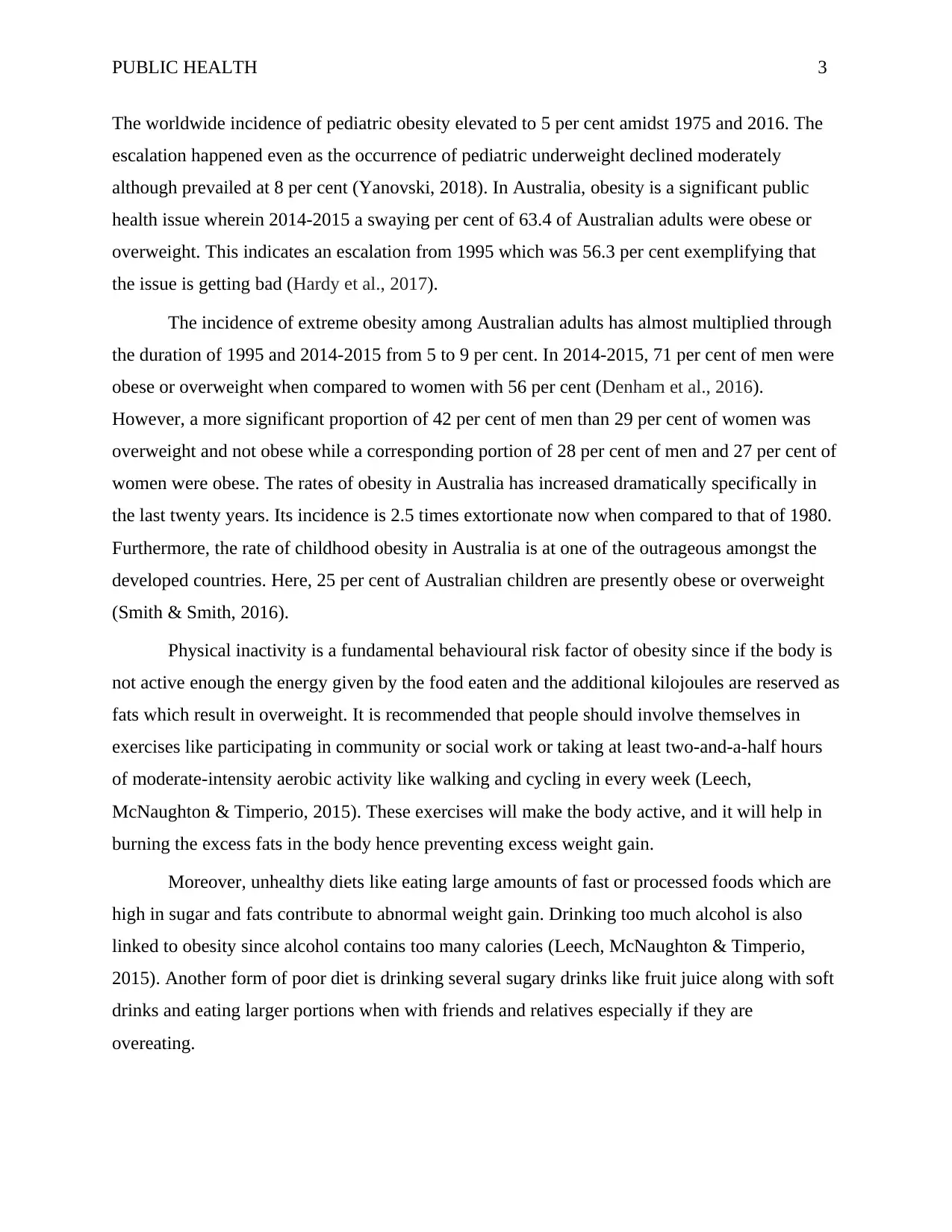
PUBLIC HEALTH 3
The worldwide incidence of pediatric obesity elevated to 5 per cent amidst 1975 and 2016. The
escalation happened even as the occurrence of pediatric underweight declined moderately
although prevailed at 8 per cent (Yanovski, 2018). In Australia, obesity is a significant public
health issue wherein 2014-2015 a swaying per cent of 63.4 of Australian adults were obese or
overweight. This indicates an escalation from 1995 which was 56.3 per cent exemplifying that
the issue is getting bad (Hardy et al., 2017).
The incidence of extreme obesity among Australian adults has almost multiplied through
the duration of 1995 and 2014-2015 from 5 to 9 per cent. In 2014-2015, 71 per cent of men were
obese or overweight when compared to women with 56 per cent (Denham et al., 2016).
However, a more significant proportion of 42 per cent of men than 29 per cent of women was
overweight and not obese while a corresponding portion of 28 per cent of men and 27 per cent of
women were obese. The rates of obesity in Australia has increased dramatically specifically in
the last twenty years. Its incidence is 2.5 times extortionate now when compared to that of 1980.
Furthermore, the rate of childhood obesity in Australia is at one of the outrageous amongst the
developed countries. Here, 25 per cent of Australian children are presently obese or overweight
(Smith & Smith, 2016).
Physical inactivity is a fundamental behavioural risk factor of obesity since if the body is
not active enough the energy given by the food eaten and the additional kilojoules are reserved as
fats which result in overweight. It is recommended that people should involve themselves in
exercises like participating in community or social work or taking at least two-and-a-half hours
of moderate-intensity aerobic activity like walking and cycling in every week (Leech,
McNaughton & Timperio, 2015). These exercises will make the body active, and it will help in
burning the excess fats in the body hence preventing excess weight gain.
Moreover, unhealthy diets like eating large amounts of fast or processed foods which are
high in sugar and fats contribute to abnormal weight gain. Drinking too much alcohol is also
linked to obesity since alcohol contains too many calories (Leech, McNaughton & Timperio,
2015). Another form of poor diet is drinking several sugary drinks like fruit juice along with soft
drinks and eating larger portions when with friends and relatives especially if they are
overeating.
The worldwide incidence of pediatric obesity elevated to 5 per cent amidst 1975 and 2016. The
escalation happened even as the occurrence of pediatric underweight declined moderately
although prevailed at 8 per cent (Yanovski, 2018). In Australia, obesity is a significant public
health issue wherein 2014-2015 a swaying per cent of 63.4 of Australian adults were obese or
overweight. This indicates an escalation from 1995 which was 56.3 per cent exemplifying that
the issue is getting bad (Hardy et al., 2017).
The incidence of extreme obesity among Australian adults has almost multiplied through
the duration of 1995 and 2014-2015 from 5 to 9 per cent. In 2014-2015, 71 per cent of men were
obese or overweight when compared to women with 56 per cent (Denham et al., 2016).
However, a more significant proportion of 42 per cent of men than 29 per cent of women was
overweight and not obese while a corresponding portion of 28 per cent of men and 27 per cent of
women were obese. The rates of obesity in Australia has increased dramatically specifically in
the last twenty years. Its incidence is 2.5 times extortionate now when compared to that of 1980.
Furthermore, the rate of childhood obesity in Australia is at one of the outrageous amongst the
developed countries. Here, 25 per cent of Australian children are presently obese or overweight
(Smith & Smith, 2016).
Physical inactivity is a fundamental behavioural risk factor of obesity since if the body is
not active enough the energy given by the food eaten and the additional kilojoules are reserved as
fats which result in overweight. It is recommended that people should involve themselves in
exercises like participating in community or social work or taking at least two-and-a-half hours
of moderate-intensity aerobic activity like walking and cycling in every week (Leech,
McNaughton & Timperio, 2015). These exercises will make the body active, and it will help in
burning the excess fats in the body hence preventing excess weight gain.
Moreover, unhealthy diets like eating large amounts of fast or processed foods which are
high in sugar and fats contribute to abnormal weight gain. Drinking too much alcohol is also
linked to obesity since alcohol contains too many calories (Leech, McNaughton & Timperio,
2015). Another form of poor diet is drinking several sugary drinks like fruit juice along with soft
drinks and eating larger portions when with friends and relatives especially if they are
overeating.
⊘ This is a preview!⊘
Do you want full access?
Subscribe today to unlock all pages.

Trusted by 1+ million students worldwide
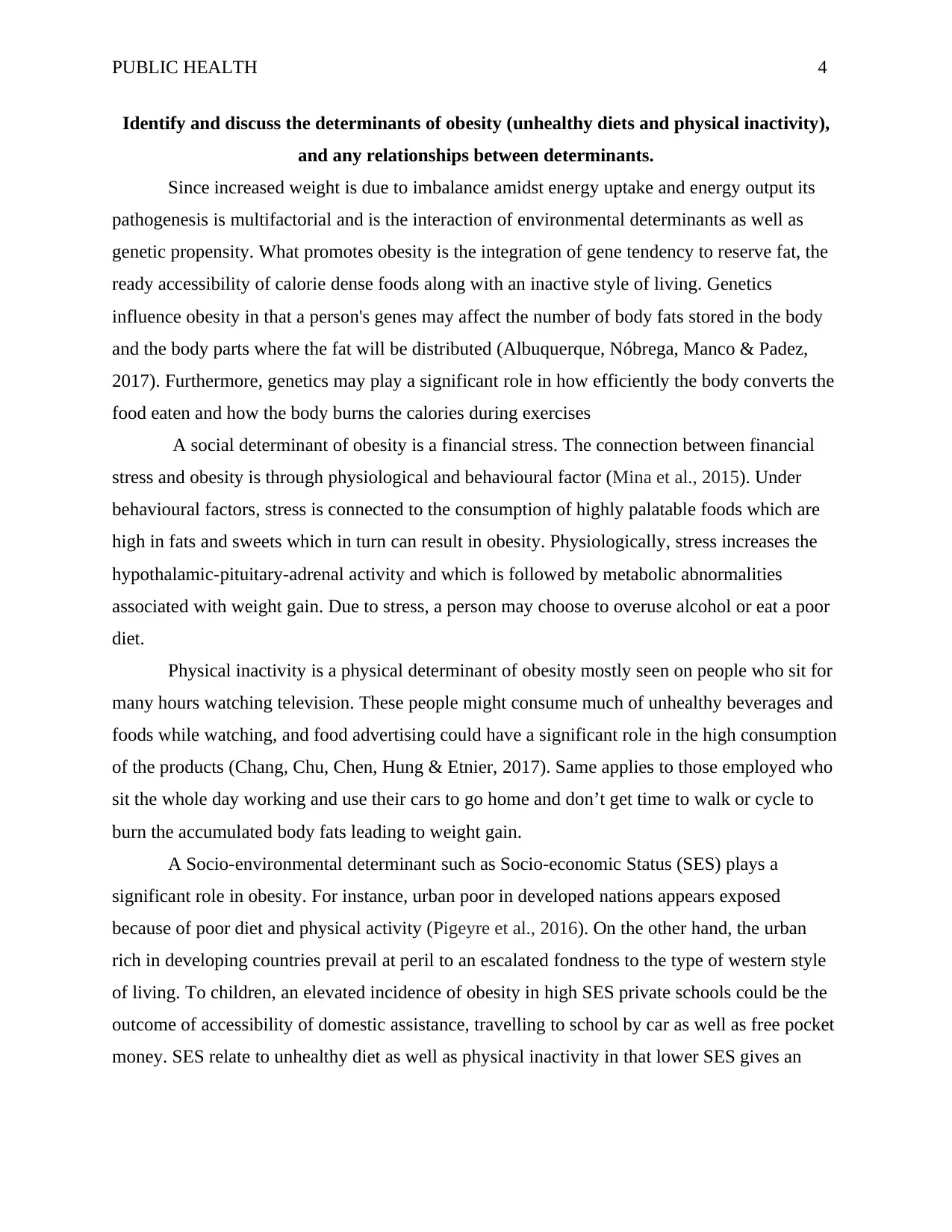
PUBLIC HEALTH 4
Identify and discuss the determinants of obesity (unhealthy diets and physical inactivity),
and any relationships between determinants.
Since increased weight is due to imbalance amidst energy uptake and energy output its
pathogenesis is multifactorial and is the interaction of environmental determinants as well as
genetic propensity. What promotes obesity is the integration of gene tendency to reserve fat, the
ready accessibility of calorie dense foods along with an inactive style of living. Genetics
influence obesity in that a person's genes may affect the number of body fats stored in the body
and the body parts where the fat will be distributed (Albuquerque, Nóbrega, Manco & Padez,
2017). Furthermore, genetics may play a significant role in how efficiently the body converts the
food eaten and how the body burns the calories during exercises
A social determinant of obesity is a financial stress. The connection between financial
stress and obesity is through physiological and behavioural factor (Mina et al., 2015). Under
behavioural factors, stress is connected to the consumption of highly palatable foods which are
high in fats and sweets which in turn can result in obesity. Physiologically, stress increases the
hypothalamic-pituitary-adrenal activity and which is followed by metabolic abnormalities
associated with weight gain. Due to stress, a person may choose to overuse alcohol or eat a poor
diet.
Physical inactivity is a physical determinant of obesity mostly seen on people who sit for
many hours watching television. These people might consume much of unhealthy beverages and
foods while watching, and food advertising could have a significant role in the high consumption
of the products (Chang, Chu, Chen, Hung & Etnier, 2017). Same applies to those employed who
sit the whole day working and use their cars to go home and don’t get time to walk or cycle to
burn the accumulated body fats leading to weight gain.
A Socio-environmental determinant such as Socio-economic Status (SES) plays a
significant role in obesity. For instance, urban poor in developed nations appears exposed
because of poor diet and physical activity (Pigeyre et al., 2016). On the other hand, the urban
rich in developing countries prevail at peril to an escalated fondness to the type of western style
of living. To children, an elevated incidence of obesity in high SES private schools could be the
outcome of accessibility of domestic assistance, travelling to school by car as well as free pocket
money. SES relate to unhealthy diet as well as physical inactivity in that lower SES gives an
Identify and discuss the determinants of obesity (unhealthy diets and physical inactivity),
and any relationships between determinants.
Since increased weight is due to imbalance amidst energy uptake and energy output its
pathogenesis is multifactorial and is the interaction of environmental determinants as well as
genetic propensity. What promotes obesity is the integration of gene tendency to reserve fat, the
ready accessibility of calorie dense foods along with an inactive style of living. Genetics
influence obesity in that a person's genes may affect the number of body fats stored in the body
and the body parts where the fat will be distributed (Albuquerque, Nóbrega, Manco & Padez,
2017). Furthermore, genetics may play a significant role in how efficiently the body converts the
food eaten and how the body burns the calories during exercises
A social determinant of obesity is a financial stress. The connection between financial
stress and obesity is through physiological and behavioural factor (Mina et al., 2015). Under
behavioural factors, stress is connected to the consumption of highly palatable foods which are
high in fats and sweets which in turn can result in obesity. Physiologically, stress increases the
hypothalamic-pituitary-adrenal activity and which is followed by metabolic abnormalities
associated with weight gain. Due to stress, a person may choose to overuse alcohol or eat a poor
diet.
Physical inactivity is a physical determinant of obesity mostly seen on people who sit for
many hours watching television. These people might consume much of unhealthy beverages and
foods while watching, and food advertising could have a significant role in the high consumption
of the products (Chang, Chu, Chen, Hung & Etnier, 2017). Same applies to those employed who
sit the whole day working and use their cars to go home and don’t get time to walk or cycle to
burn the accumulated body fats leading to weight gain.
A Socio-environmental determinant such as Socio-economic Status (SES) plays a
significant role in obesity. For instance, urban poor in developed nations appears exposed
because of poor diet and physical activity (Pigeyre et al., 2016). On the other hand, the urban
rich in developing countries prevail at peril to an escalated fondness to the type of western style
of living. To children, an elevated incidence of obesity in high SES private schools could be the
outcome of accessibility of domestic assistance, travelling to school by car as well as free pocket
money. SES relate to unhealthy diet as well as physical inactivity in that lower SES gives an
Paraphrase This Document
Need a fresh take? Get an instant paraphrase of this document with our AI Paraphraser
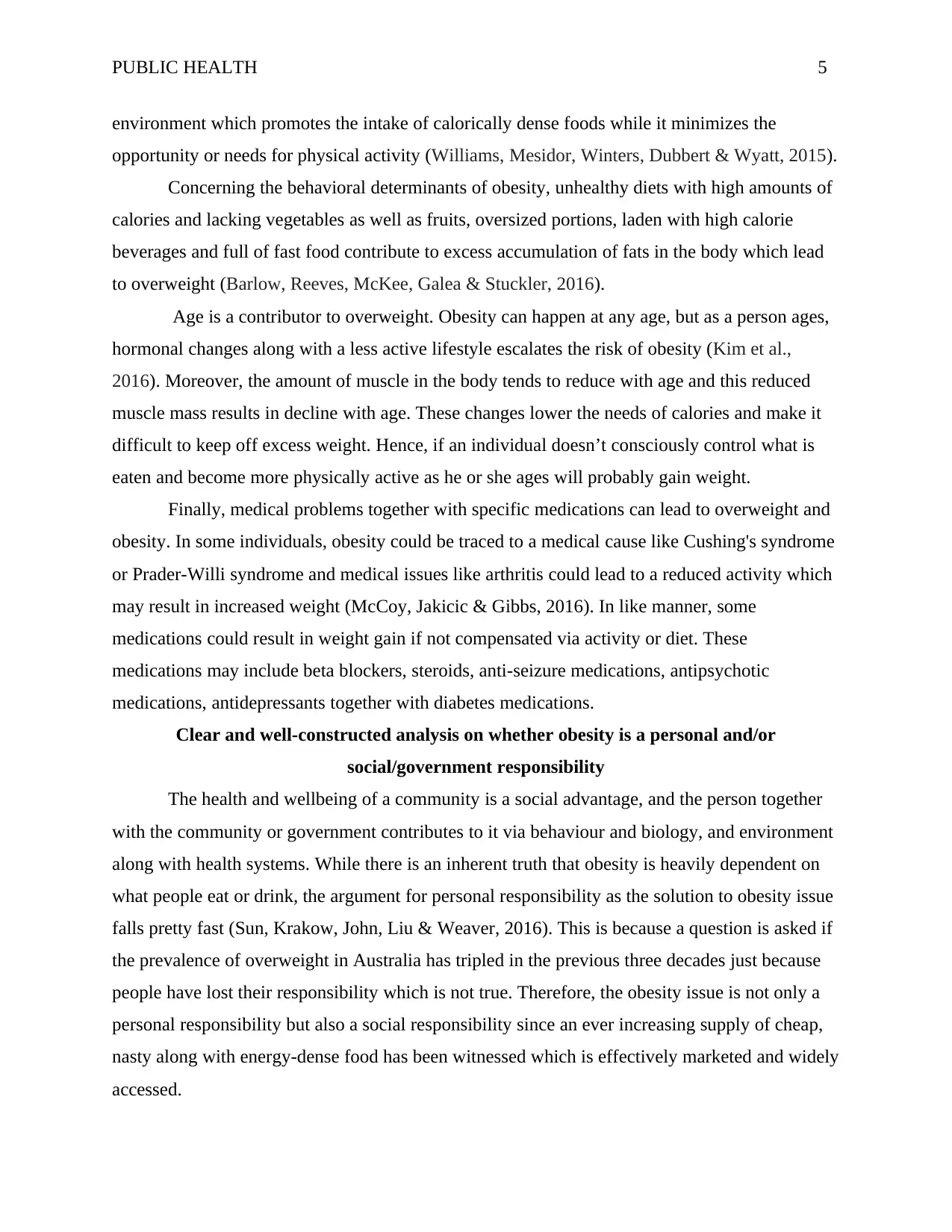
PUBLIC HEALTH 5
environment which promotes the intake of calorically dense foods while it minimizes the
opportunity or needs for physical activity (Williams, Mesidor, Winters, Dubbert & Wyatt, 2015).
Concerning the behavioral determinants of obesity, unhealthy diets with high amounts of
calories and lacking vegetables as well as fruits, oversized portions, laden with high calorie
beverages and full of fast food contribute to excess accumulation of fats in the body which lead
to overweight (Barlow, Reeves, McKee, Galea & Stuckler, 2016).
Age is a contributor to overweight. Obesity can happen at any age, but as a person ages,
hormonal changes along with a less active lifestyle escalates the risk of obesity (Kim et al.,
2016). Moreover, the amount of muscle in the body tends to reduce with age and this reduced
muscle mass results in decline with age. These changes lower the needs of calories and make it
difficult to keep off excess weight. Hence, if an individual doesn’t consciously control what is
eaten and become more physically active as he or she ages will probably gain weight.
Finally, medical problems together with specific medications can lead to overweight and
obesity. In some individuals, obesity could be traced to a medical cause like Cushing's syndrome
or Prader-Willi syndrome and medical issues like arthritis could lead to a reduced activity which
may result in increased weight (McCoy, Jakicic & Gibbs, 2016). In like manner, some
medications could result in weight gain if not compensated via activity or diet. These
medications may include beta blockers, steroids, anti-seizure medications, antipsychotic
medications, antidepressants together with diabetes medications.
Clear and well-constructed analysis on whether obesity is a personal and/or
social/government responsibility
The health and wellbeing of a community is a social advantage, and the person together
with the community or government contributes to it via behaviour and biology, and environment
along with health systems. While there is an inherent truth that obesity is heavily dependent on
what people eat or drink, the argument for personal responsibility as the solution to obesity issue
falls pretty fast (Sun, Krakow, John, Liu & Weaver, 2016). This is because a question is asked if
the prevalence of overweight in Australia has tripled in the previous three decades just because
people have lost their responsibility which is not true. Therefore, the obesity issue is not only a
personal responsibility but also a social responsibility since an ever increasing supply of cheap,
nasty along with energy-dense food has been witnessed which is effectively marketed and widely
accessed.
environment which promotes the intake of calorically dense foods while it minimizes the
opportunity or needs for physical activity (Williams, Mesidor, Winters, Dubbert & Wyatt, 2015).
Concerning the behavioral determinants of obesity, unhealthy diets with high amounts of
calories and lacking vegetables as well as fruits, oversized portions, laden with high calorie
beverages and full of fast food contribute to excess accumulation of fats in the body which lead
to overweight (Barlow, Reeves, McKee, Galea & Stuckler, 2016).
Age is a contributor to overweight. Obesity can happen at any age, but as a person ages,
hormonal changes along with a less active lifestyle escalates the risk of obesity (Kim et al.,
2016). Moreover, the amount of muscle in the body tends to reduce with age and this reduced
muscle mass results in decline with age. These changes lower the needs of calories and make it
difficult to keep off excess weight. Hence, if an individual doesn’t consciously control what is
eaten and become more physically active as he or she ages will probably gain weight.
Finally, medical problems together with specific medications can lead to overweight and
obesity. In some individuals, obesity could be traced to a medical cause like Cushing's syndrome
or Prader-Willi syndrome and medical issues like arthritis could lead to a reduced activity which
may result in increased weight (McCoy, Jakicic & Gibbs, 2016). In like manner, some
medications could result in weight gain if not compensated via activity or diet. These
medications may include beta blockers, steroids, anti-seizure medications, antipsychotic
medications, antidepressants together with diabetes medications.
Clear and well-constructed analysis on whether obesity is a personal and/or
social/government responsibility
The health and wellbeing of a community is a social advantage, and the person together
with the community or government contributes to it via behaviour and biology, and environment
along with health systems. While there is an inherent truth that obesity is heavily dependent on
what people eat or drink, the argument for personal responsibility as the solution to obesity issue
falls pretty fast (Sun, Krakow, John, Liu & Weaver, 2016). This is because a question is asked if
the prevalence of overweight in Australia has tripled in the previous three decades just because
people have lost their responsibility which is not true. Therefore, the obesity issue is not only a
personal responsibility but also a social responsibility since an ever increasing supply of cheap,
nasty along with energy-dense food has been witnessed which is effectively marketed and widely
accessed.
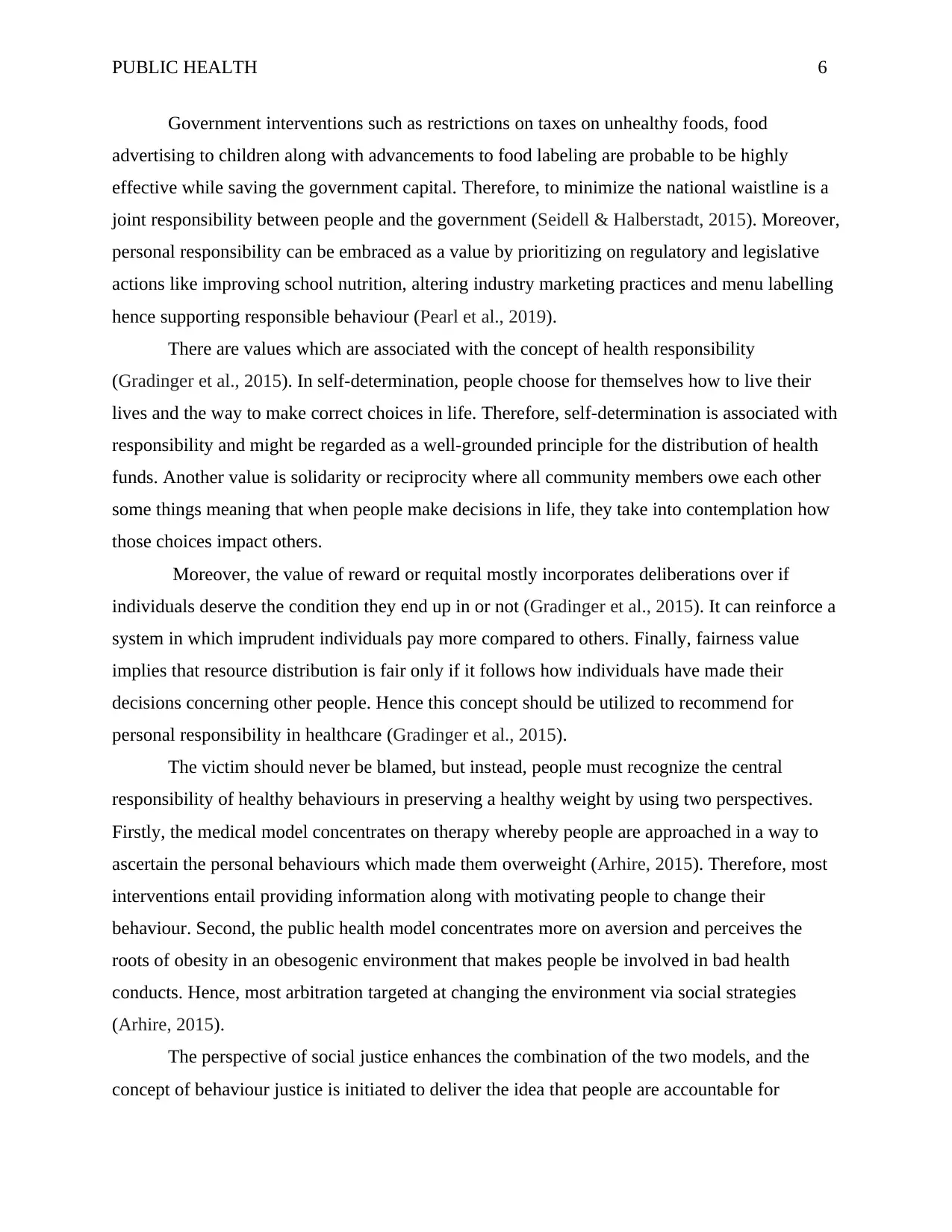
PUBLIC HEALTH 6
Government interventions such as restrictions on taxes on unhealthy foods, food
advertising to children along with advancements to food labeling are probable to be highly
effective while saving the government capital. Therefore, to minimize the national waistline is a
joint responsibility between people and the government (Seidell & Halberstadt, 2015). Moreover,
personal responsibility can be embraced as a value by prioritizing on regulatory and legislative
actions like improving school nutrition, altering industry marketing practices and menu labelling
hence supporting responsible behaviour (Pearl et al., 2019).
There are values which are associated with the concept of health responsibility
(Gradinger et al., 2015). In self-determination, people choose for themselves how to live their
lives and the way to make correct choices in life. Therefore, self-determination is associated with
responsibility and might be regarded as a well-grounded principle for the distribution of health
funds. Another value is solidarity or reciprocity where all community members owe each other
some things meaning that when people make decisions in life, they take into contemplation how
those choices impact others.
Moreover, the value of reward or requital mostly incorporates deliberations over if
individuals deserve the condition they end up in or not (Gradinger et al., 2015). It can reinforce a
system in which imprudent individuals pay more compared to others. Finally, fairness value
implies that resource distribution is fair only if it follows how individuals have made their
decisions concerning other people. Hence this concept should be utilized to recommend for
personal responsibility in healthcare (Gradinger et al., 2015).
The victim should never be blamed, but instead, people must recognize the central
responsibility of healthy behaviours in preserving a healthy weight by using two perspectives.
Firstly, the medical model concentrates on therapy whereby people are approached in a way to
ascertain the personal behaviours which made them overweight (Arhire, 2015). Therefore, most
interventions entail providing information along with motivating people to change their
behaviour. Second, the public health model concentrates more on aversion and perceives the
roots of obesity in an obesogenic environment that makes people be involved in bad health
conducts. Hence, most arbitration targeted at changing the environment via social strategies
(Arhire, 2015).
The perspective of social justice enhances the combination of the two models, and the
concept of behaviour justice is initiated to deliver the idea that people are accountable for
Government interventions such as restrictions on taxes on unhealthy foods, food
advertising to children along with advancements to food labeling are probable to be highly
effective while saving the government capital. Therefore, to minimize the national waistline is a
joint responsibility between people and the government (Seidell & Halberstadt, 2015). Moreover,
personal responsibility can be embraced as a value by prioritizing on regulatory and legislative
actions like improving school nutrition, altering industry marketing practices and menu labelling
hence supporting responsible behaviour (Pearl et al., 2019).
There are values which are associated with the concept of health responsibility
(Gradinger et al., 2015). In self-determination, people choose for themselves how to live their
lives and the way to make correct choices in life. Therefore, self-determination is associated with
responsibility and might be regarded as a well-grounded principle for the distribution of health
funds. Another value is solidarity or reciprocity where all community members owe each other
some things meaning that when people make decisions in life, they take into contemplation how
those choices impact others.
Moreover, the value of reward or requital mostly incorporates deliberations over if
individuals deserve the condition they end up in or not (Gradinger et al., 2015). It can reinforce a
system in which imprudent individuals pay more compared to others. Finally, fairness value
implies that resource distribution is fair only if it follows how individuals have made their
decisions concerning other people. Hence this concept should be utilized to recommend for
personal responsibility in healthcare (Gradinger et al., 2015).
The victim should never be blamed, but instead, people must recognize the central
responsibility of healthy behaviours in preserving a healthy weight by using two perspectives.
Firstly, the medical model concentrates on therapy whereby people are approached in a way to
ascertain the personal behaviours which made them overweight (Arhire, 2015). Therefore, most
interventions entail providing information along with motivating people to change their
behaviour. Second, the public health model concentrates more on aversion and perceives the
roots of obesity in an obesogenic environment that makes people be involved in bad health
conducts. Hence, most arbitration targeted at changing the environment via social strategies
(Arhire, 2015).
The perspective of social justice enhances the combination of the two models, and the
concept of behaviour justice is initiated to deliver the idea that people are accountable for
⊘ This is a preview!⊘
Do you want full access?
Subscribe today to unlock all pages.

Trusted by 1+ million students worldwide
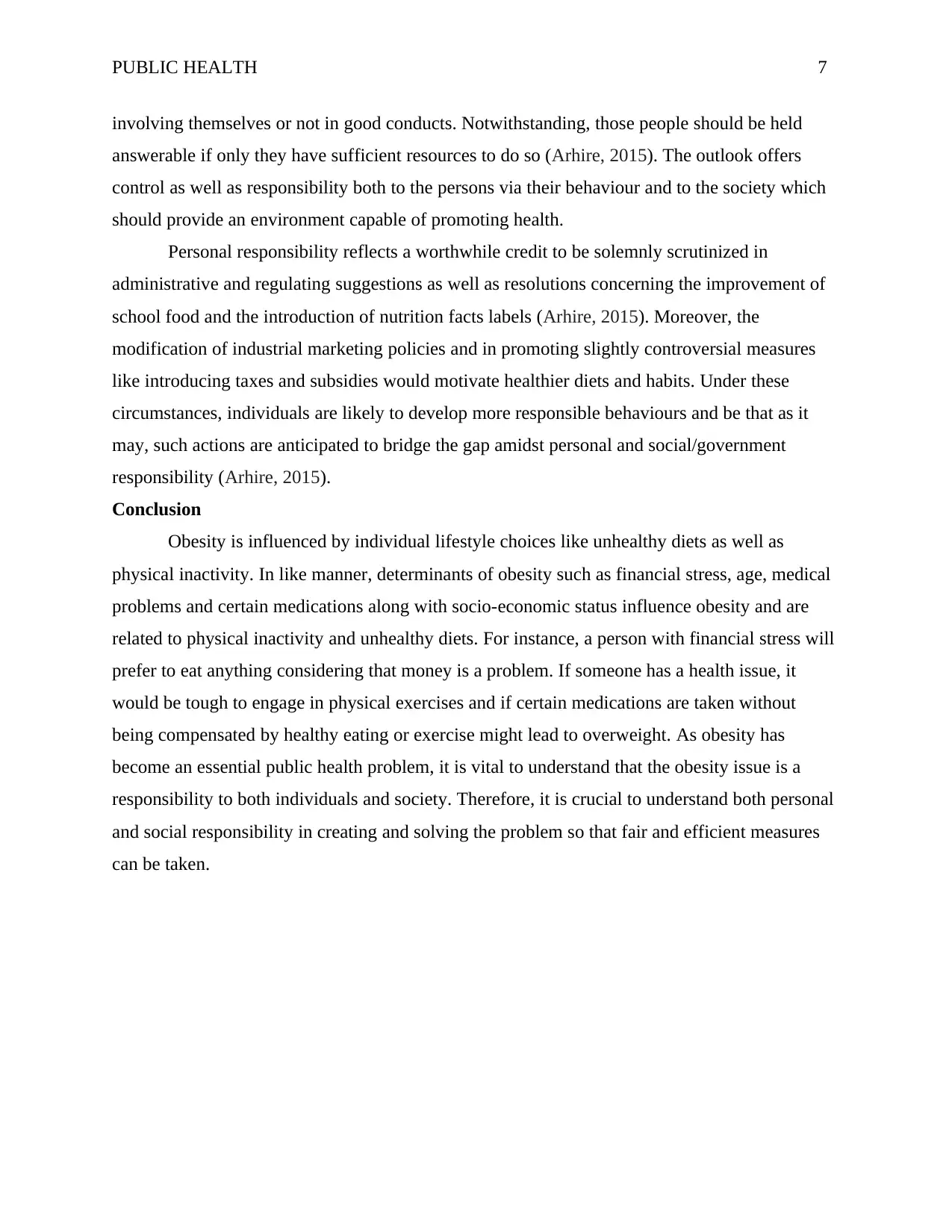
PUBLIC HEALTH 7
involving themselves or not in good conducts. Notwithstanding, those people should be held
answerable if only they have sufficient resources to do so (Arhire, 2015). The outlook offers
control as well as responsibility both to the persons via their behaviour and to the society which
should provide an environment capable of promoting health.
Personal responsibility reflects a worthwhile credit to be solemnly scrutinized in
administrative and regulating suggestions as well as resolutions concerning the improvement of
school food and the introduction of nutrition facts labels (Arhire, 2015). Moreover, the
modification of industrial marketing policies and in promoting slightly controversial measures
like introducing taxes and subsidies would motivate healthier diets and habits. Under these
circumstances, individuals are likely to develop more responsible behaviours and be that as it
may, such actions are anticipated to bridge the gap amidst personal and social/government
responsibility (Arhire, 2015).
Conclusion
Obesity is influenced by individual lifestyle choices like unhealthy diets as well as
physical inactivity. In like manner, determinants of obesity such as financial stress, age, medical
problems and certain medications along with socio-economic status influence obesity and are
related to physical inactivity and unhealthy diets. For instance, a person with financial stress will
prefer to eat anything considering that money is a problem. If someone has a health issue, it
would be tough to engage in physical exercises and if certain medications are taken without
being compensated by healthy eating or exercise might lead to overweight. As obesity has
become an essential public health problem, it is vital to understand that the obesity issue is a
responsibility to both individuals and society. Therefore, it is crucial to understand both personal
and social responsibility in creating and solving the problem so that fair and efficient measures
can be taken.
involving themselves or not in good conducts. Notwithstanding, those people should be held
answerable if only they have sufficient resources to do so (Arhire, 2015). The outlook offers
control as well as responsibility both to the persons via their behaviour and to the society which
should provide an environment capable of promoting health.
Personal responsibility reflects a worthwhile credit to be solemnly scrutinized in
administrative and regulating suggestions as well as resolutions concerning the improvement of
school food and the introduction of nutrition facts labels (Arhire, 2015). Moreover, the
modification of industrial marketing policies and in promoting slightly controversial measures
like introducing taxes and subsidies would motivate healthier diets and habits. Under these
circumstances, individuals are likely to develop more responsible behaviours and be that as it
may, such actions are anticipated to bridge the gap amidst personal and social/government
responsibility (Arhire, 2015).
Conclusion
Obesity is influenced by individual lifestyle choices like unhealthy diets as well as
physical inactivity. In like manner, determinants of obesity such as financial stress, age, medical
problems and certain medications along with socio-economic status influence obesity and are
related to physical inactivity and unhealthy diets. For instance, a person with financial stress will
prefer to eat anything considering that money is a problem. If someone has a health issue, it
would be tough to engage in physical exercises and if certain medications are taken without
being compensated by healthy eating or exercise might lead to overweight. As obesity has
become an essential public health problem, it is vital to understand that the obesity issue is a
responsibility to both individuals and society. Therefore, it is crucial to understand both personal
and social responsibility in creating and solving the problem so that fair and efficient measures
can be taken.
Paraphrase This Document
Need a fresh take? Get an instant paraphrase of this document with our AI Paraphraser
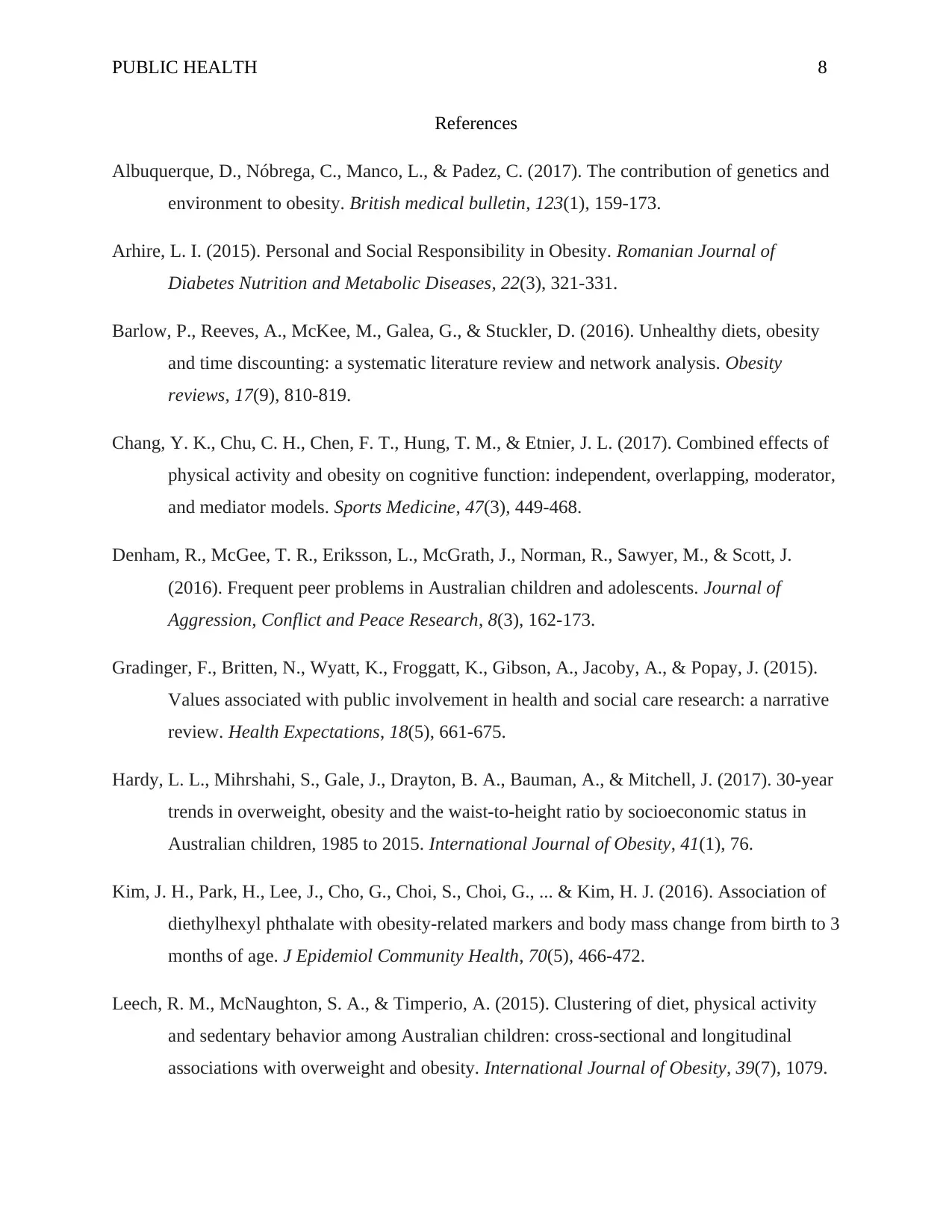
PUBLIC HEALTH 8
References
Albuquerque, D., Nóbrega, C., Manco, L., & Padez, C. (2017). The contribution of genetics and
environment to obesity. British medical bulletin, 123(1), 159-173.
Arhire, L. I. (2015). Personal and Social Responsibility in Obesity. Romanian Journal of
Diabetes Nutrition and Metabolic Diseases, 22(3), 321-331.
Barlow, P., Reeves, A., McKee, M., Galea, G., & Stuckler, D. (2016). Unhealthy diets, obesity
and time discounting: a systematic literature review and network analysis. Obesity
reviews, 17(9), 810-819.
Chang, Y. K., Chu, C. H., Chen, F. T., Hung, T. M., & Etnier, J. L. (2017). Combined effects of
physical activity and obesity on cognitive function: independent, overlapping, moderator,
and mediator models. Sports Medicine, 47(3), 449-468.
Denham, R., McGee, T. R., Eriksson, L., McGrath, J., Norman, R., Sawyer, M., & Scott, J.
(2016). Frequent peer problems in Australian children and adolescents. Journal of
Aggression, Conflict and Peace Research, 8(3), 162-173.
Gradinger, F., Britten, N., Wyatt, K., Froggatt, K., Gibson, A., Jacoby, A., & Popay, J. (2015).
Values associated with public involvement in health and social care research: a narrative
review. Health Expectations, 18(5), 661-675.
Hardy, L. L., Mihrshahi, S., Gale, J., Drayton, B. A., Bauman, A., & Mitchell, J. (2017). 30-year
trends in overweight, obesity and the waist-to-height ratio by socioeconomic status in
Australian children, 1985 to 2015. International Journal of Obesity, 41(1), 76.
Kim, J. H., Park, H., Lee, J., Cho, G., Choi, S., Choi, G., ... & Kim, H. J. (2016). Association of
diethylhexyl phthalate with obesity-related markers and body mass change from birth to 3
months of age. J Epidemiol Community Health, 70(5), 466-472.
Leech, R. M., McNaughton, S. A., & Timperio, A. (2015). Clustering of diet, physical activity
and sedentary behavior among Australian children: cross-sectional and longitudinal
associations with overweight and obesity. International Journal of Obesity, 39(7), 1079.
References
Albuquerque, D., Nóbrega, C., Manco, L., & Padez, C. (2017). The contribution of genetics and
environment to obesity. British medical bulletin, 123(1), 159-173.
Arhire, L. I. (2015). Personal and Social Responsibility in Obesity. Romanian Journal of
Diabetes Nutrition and Metabolic Diseases, 22(3), 321-331.
Barlow, P., Reeves, A., McKee, M., Galea, G., & Stuckler, D. (2016). Unhealthy diets, obesity
and time discounting: a systematic literature review and network analysis. Obesity
reviews, 17(9), 810-819.
Chang, Y. K., Chu, C. H., Chen, F. T., Hung, T. M., & Etnier, J. L. (2017). Combined effects of
physical activity and obesity on cognitive function: independent, overlapping, moderator,
and mediator models. Sports Medicine, 47(3), 449-468.
Denham, R., McGee, T. R., Eriksson, L., McGrath, J., Norman, R., Sawyer, M., & Scott, J.
(2016). Frequent peer problems in Australian children and adolescents. Journal of
Aggression, Conflict and Peace Research, 8(3), 162-173.
Gradinger, F., Britten, N., Wyatt, K., Froggatt, K., Gibson, A., Jacoby, A., & Popay, J. (2015).
Values associated with public involvement in health and social care research: a narrative
review. Health Expectations, 18(5), 661-675.
Hardy, L. L., Mihrshahi, S., Gale, J., Drayton, B. A., Bauman, A., & Mitchell, J. (2017). 30-year
trends in overweight, obesity and the waist-to-height ratio by socioeconomic status in
Australian children, 1985 to 2015. International Journal of Obesity, 41(1), 76.
Kim, J. H., Park, H., Lee, J., Cho, G., Choi, S., Choi, G., ... & Kim, H. J. (2016). Association of
diethylhexyl phthalate with obesity-related markers and body mass change from birth to 3
months of age. J Epidemiol Community Health, 70(5), 466-472.
Leech, R. M., McNaughton, S. A., & Timperio, A. (2015). Clustering of diet, physical activity
and sedentary behavior among Australian children: cross-sectional and longitudinal
associations with overweight and obesity. International Journal of Obesity, 39(7), 1079.
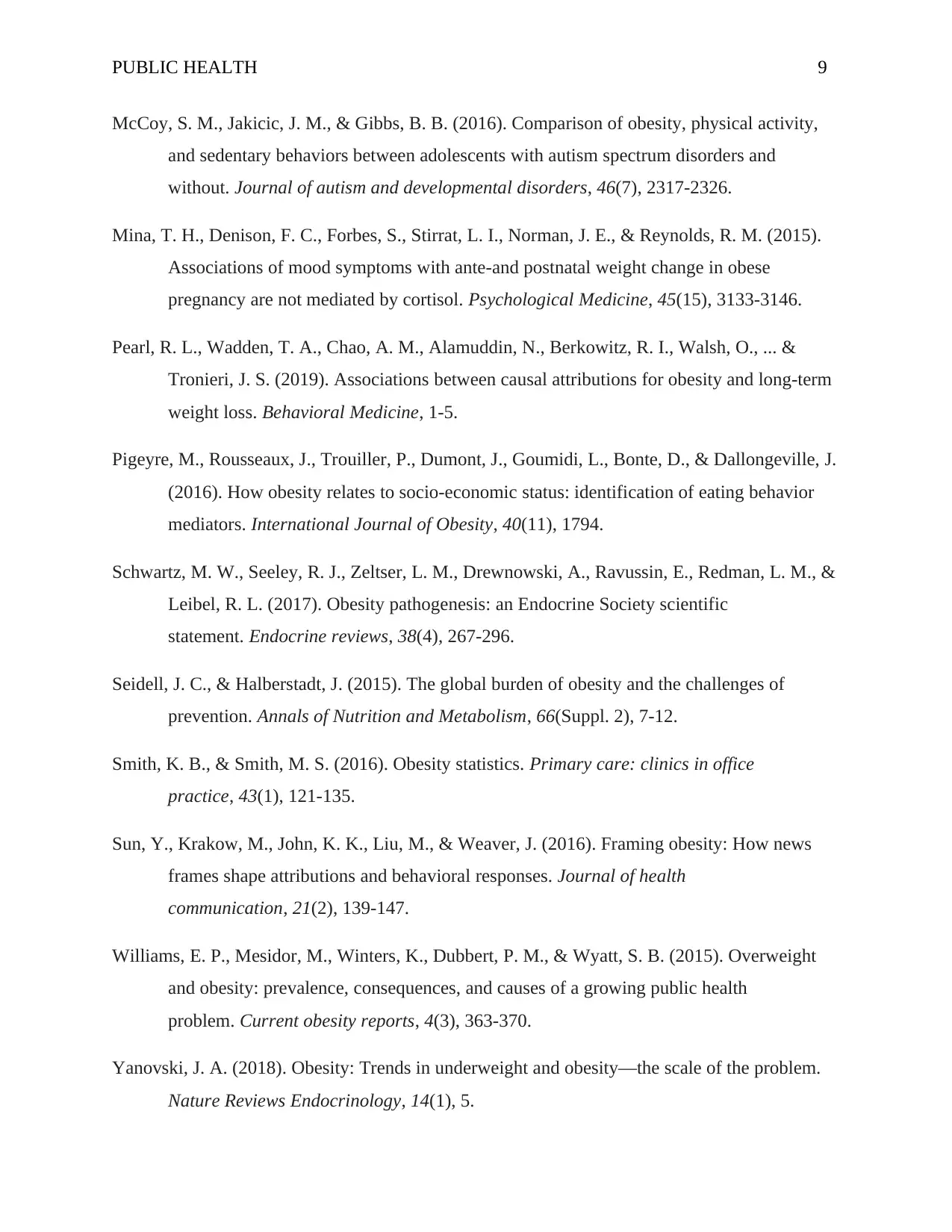
PUBLIC HEALTH 9
McCoy, S. M., Jakicic, J. M., & Gibbs, B. B. (2016). Comparison of obesity, physical activity,
and sedentary behaviors between adolescents with autism spectrum disorders and
without. Journal of autism and developmental disorders, 46(7), 2317-2326.
Mina, T. H., Denison, F. C., Forbes, S., Stirrat, L. I., Norman, J. E., & Reynolds, R. M. (2015).
Associations of mood symptoms with ante-and postnatal weight change in obese
pregnancy are not mediated by cortisol. Psychological Medicine, 45(15), 3133-3146.
Pearl, R. L., Wadden, T. A., Chao, A. M., Alamuddin, N., Berkowitz, R. I., Walsh, O., ... &
Tronieri, J. S. (2019). Associations between causal attributions for obesity and long-term
weight loss. Behavioral Medicine, 1-5.
Pigeyre, M., Rousseaux, J., Trouiller, P., Dumont, J., Goumidi, L., Bonte, D., & Dallongeville, J.
(2016). How obesity relates to socio-economic status: identification of eating behavior
mediators. International Journal of Obesity, 40(11), 1794.
Schwartz, M. W., Seeley, R. J., Zeltser, L. M., Drewnowski, A., Ravussin, E., Redman, L. M., &
Leibel, R. L. (2017). Obesity pathogenesis: an Endocrine Society scientific
statement. Endocrine reviews, 38(4), 267-296.
Seidell, J. C., & Halberstadt, J. (2015). The global burden of obesity and the challenges of
prevention. Annals of Nutrition and Metabolism, 66(Suppl. 2), 7-12.
Smith, K. B., & Smith, M. S. (2016). Obesity statistics. Primary care: clinics in office
practice, 43(1), 121-135.
Sun, Y., Krakow, M., John, K. K., Liu, M., & Weaver, J. (2016). Framing obesity: How news
frames shape attributions and behavioral responses. Journal of health
communication, 21(2), 139-147.
Williams, E. P., Mesidor, M., Winters, K., Dubbert, P. M., & Wyatt, S. B. (2015). Overweight
and obesity: prevalence, consequences, and causes of a growing public health
problem. Current obesity reports, 4(3), 363-370.
Yanovski, J. A. (2018). Obesity: Trends in underweight and obesity—the scale of the problem.
Nature Reviews Endocrinology, 14(1), 5.
McCoy, S. M., Jakicic, J. M., & Gibbs, B. B. (2016). Comparison of obesity, physical activity,
and sedentary behaviors between adolescents with autism spectrum disorders and
without. Journal of autism and developmental disorders, 46(7), 2317-2326.
Mina, T. H., Denison, F. C., Forbes, S., Stirrat, L. I., Norman, J. E., & Reynolds, R. M. (2015).
Associations of mood symptoms with ante-and postnatal weight change in obese
pregnancy are not mediated by cortisol. Psychological Medicine, 45(15), 3133-3146.
Pearl, R. L., Wadden, T. A., Chao, A. M., Alamuddin, N., Berkowitz, R. I., Walsh, O., ... &
Tronieri, J. S. (2019). Associations between causal attributions for obesity and long-term
weight loss. Behavioral Medicine, 1-5.
Pigeyre, M., Rousseaux, J., Trouiller, P., Dumont, J., Goumidi, L., Bonte, D., & Dallongeville, J.
(2016). How obesity relates to socio-economic status: identification of eating behavior
mediators. International Journal of Obesity, 40(11), 1794.
Schwartz, M. W., Seeley, R. J., Zeltser, L. M., Drewnowski, A., Ravussin, E., Redman, L. M., &
Leibel, R. L. (2017). Obesity pathogenesis: an Endocrine Society scientific
statement. Endocrine reviews, 38(4), 267-296.
Seidell, J. C., & Halberstadt, J. (2015). The global burden of obesity and the challenges of
prevention. Annals of Nutrition and Metabolism, 66(Suppl. 2), 7-12.
Smith, K. B., & Smith, M. S. (2016). Obesity statistics. Primary care: clinics in office
practice, 43(1), 121-135.
Sun, Y., Krakow, M., John, K. K., Liu, M., & Weaver, J. (2016). Framing obesity: How news
frames shape attributions and behavioral responses. Journal of health
communication, 21(2), 139-147.
Williams, E. P., Mesidor, M., Winters, K., Dubbert, P. M., & Wyatt, S. B. (2015). Overweight
and obesity: prevalence, consequences, and causes of a growing public health
problem. Current obesity reports, 4(3), 363-370.
Yanovski, J. A. (2018). Obesity: Trends in underweight and obesity—the scale of the problem.
Nature Reviews Endocrinology, 14(1), 5.
⊘ This is a preview!⊘
Do you want full access?
Subscribe today to unlock all pages.

Trusted by 1+ million students worldwide
1 out of 9
Related Documents
Your All-in-One AI-Powered Toolkit for Academic Success.
+13062052269
info@desklib.com
Available 24*7 on WhatsApp / Email
![[object Object]](/_next/static/media/star-bottom.7253800d.svg)
Unlock your academic potential
Copyright © 2020–2025 A2Z Services. All Rights Reserved. Developed and managed by ZUCOL.





